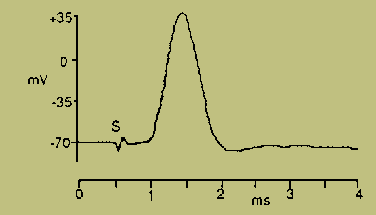
They're all in the chapters of Book 2, in the relevant sections. The idea behind these questions is just to get you sifting through the text to pick out the information for the answers. So… you'll not find a link to a file of the answers - but maybe we could work on that at the next tutorial.
1. What is the central nervous system (CNS)? How does the CNS differ from the peripheral nervous system?
2. Explain the difference between nerves, neurons and axons.
3. How can action potentials convey information in the nervous system?
4. Motor bikes are noisy; is `noise' a component of a motor
bike?
1. Give 2 similarities and 2 differences between amoebae and neurons.
2. Why aren't all neurons the same?
3. Draw a simple labelled diagram of a `classical' neuron, showing the: cell body, nucleus, cell membrane, dendrites, axon and axon hillock.
4. How do neurons communicate with other neurons?
5. Indicate the inputs to and outputs from the neuron you drew in answer to Q.3.
6. Draw a simple diagram of a synapse, showing the: presynaptic cell, postsynaptic cell, synaptic cleft, vesicles, transmitter.
7. The term `receptor' is used in 2 different ways: explain the difference between them.
8. Why are sensory receptors referred to as `biological transducers'?
9. Indicate the differences between receptor potentials, synaptic potentials and action potentials.
10. What is wrong with the term `inhibitory action potential'?
11. What is the difference between `sensory neurons' and `motor neurons'? Are there any other types of neuron?
12. In addition to neurons, what other cells are found
in the nervous system?
1. What is the difference between the terms (i) `voltage' and `current' and (ii) `resistance' and `conductance'?
2. What is the difference between atoms, molecules and ions?
3. Name the principal cation and anion in (i) extracellular fluid and (ii) intracellular fluid?
4. Explain the difference between a permeable and a semipermeable membrane.
5. What is diffusion?
6. What is a concentration gradient? How do ions/molecules move with respect to a concentration gradient?
7. How does electrical potential affect the diffusion of
ions?

8. The Figure shows a recording of an action potential
in a neuron. (S marks when the stimulus occurs) Explain how the
action potential is produced in terms of diffusion of Na+
and K+ and what is responsible for the changes in Na+
and K+ permeability.
9. What is meant by a refractory period? How does it arise and what implications does it have for neuronal function?
10. Name 2 structural features of an axon that can affect
its action potential conduction velocity.
1. What criteria must be satisfied for a given substance to be classified as a neurotransmitter?
2. Name 4 neurotransmitters.
3. Describe 4 different ways in which drugs can modify transmission at a chemical synapse. (Hint: think of the events involved in synaptic transmission.)
4. Explain how the catecholamine noradrenaline (NA) can have both excitatory and inhibitory effects. (e.g. NA released by sympathetic neurons causes contraction of smooth muscle of blood vessels, but relaxes similar smooth muscle in the intestines.)
5. Explain the difference between spatial and temporal
summation of post-synaptic potentials.
Well done, if you persisted this far!